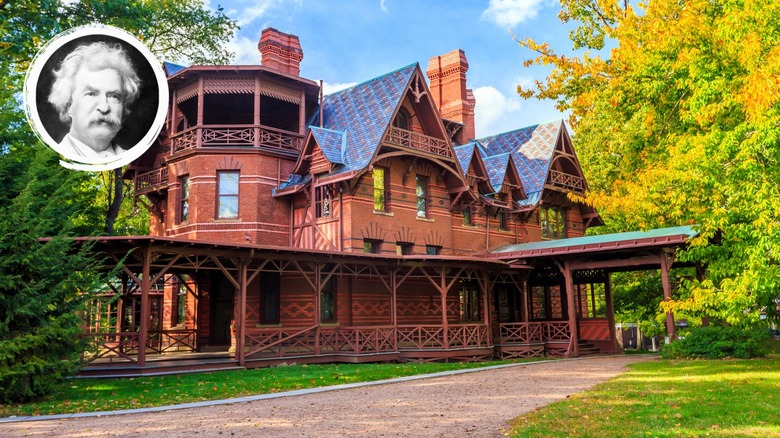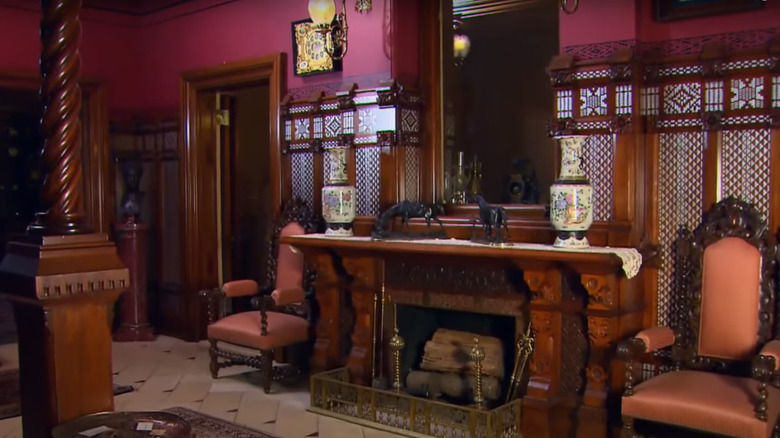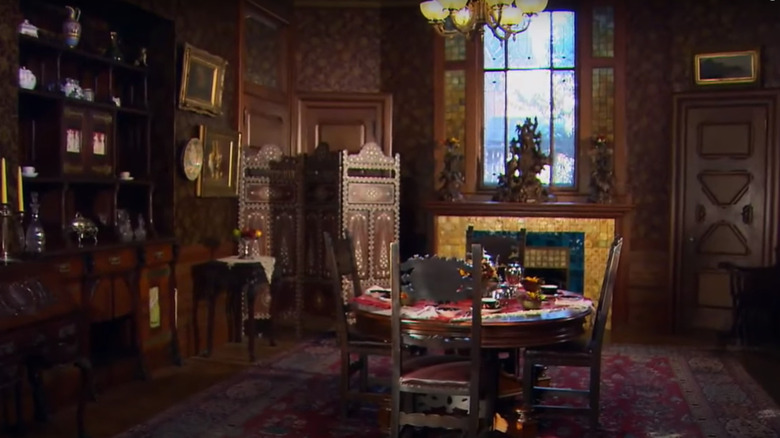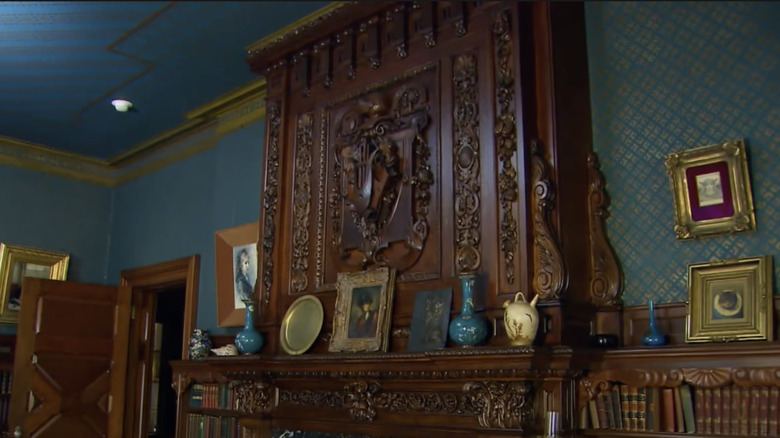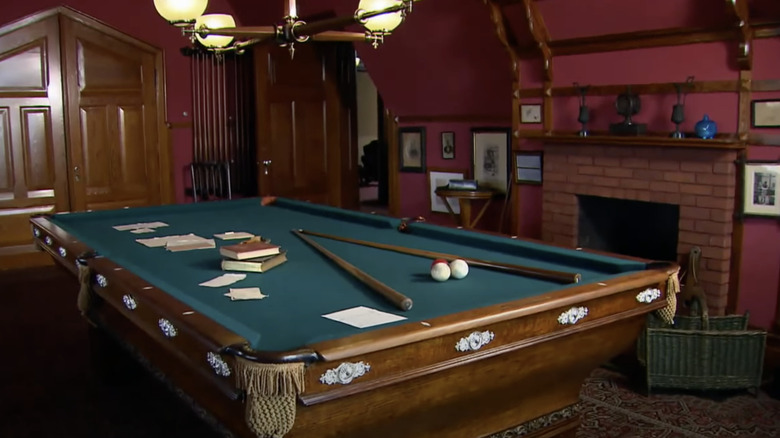Here's Where You Can Visit Mark Twain's Hartford, Connecticut Home
From 1874 until 1891, Samuel Clemens, better known by his pseudonym Mark Twain, lived with his family in a grand home constructed in the progressive Hartford, Connecticut neighborhood of Nook Farm. During this period Twain wrote many of his most famous books, all of which are now considered classics of American literature. The Mark Twain House and Museum explains that his Nook Farm neighbors included other prominent thinkers and social reformists of the time, including best-selling author Harriet Beecher Stowe and travel writer Charles Dudley Warner. The high society area was also home to a senator, a women's rights activist, and a famous actor.
The Mark Twain House, as it has come to be known, consists of 25 rooms on three floors with a total of 11,500 square feet. The home is located at 351 Farmington Avenue in Hartford, CT and can be toured via the Mark Twain House and Museum, which has been named by Forbes as "America's Best House Museum." Per Forbes, the Clemens family sold the house after they moved to Europe. For years it was used as a school and a branch location for the public library. At one point it was even rented out as apartments. The Mark Twain Memorial nonprofit took control of it in 1929 and it was later opened as a museum in the mid-1970s. Major preservation efforts have restored the home and its surrounding landscape to their original state. It received its designation as a National Historic Landmark in 1963.
Interior design inspired by faraway places
The Mark Twain house was designed and built by two American architects, Edward Tuckerman Potter and Alfred H. Thorp, who used an architectural style dubbed Mississippi Steamboat (via the Library of Congress). The interior décor, however, particularly on the first floor, was inspired by colors and patterns from the Near East such as geometrically shaped stencils and intricate woodcarvings.
Though dim due to the constraints of the gas lighting used at that time, the grand hall entryway was meant to impress visitors as soon as they entered the home. Per the Mark Twain House and Museum, French cabinetmaker and interior designer Leon Marcotte was brought in from Paris to carve the teak wood. Meanwhile, Louis Comfort Tiffany — whose father Charles Lewis Tiffany was the founder of the eponymous upscale jewelry store — and his design firm Associated Artists were hired to complete the look. Associated Artists used a palette of red, black, and iridescent silver to create an upper middle class Victorian feel in all of the common spaces of the home, including the dining room where the Clemens family hosted many lively dinner parties. Within the entrance hall, their work can be seen all the way up to the ceiling.
The drawing room and dining room hosted high-profile guests
Further Victorian-inspired rooms that were decorated by Associated Artists include the drawing room and dining room; both were used to entertain the Clemens family's many high-profile guests. As reported by Connecticut Public in their series on Connecticut's Cultural Treasures (via YouTube), lavish, excellently prepared meals were cooked by a large staff in the kitchen and then served to guests by the butler. Dinner parties were full on entertainment affairs, which often included theatrical performances by the Clemens children and, naturally, engaging and often humorous stories told around the table by Mark Twain himself.
The Mark Twain House and Museum adds that the luxurious leather look of the dining room décor comes from the lily-covered red and gold wallpaper designed by famed textile artist Candace Wheeler. The Textile Eye calls Wheeler the mother of interior design for having been one of the earliest female professional designers in America. She was also a known feminist, a teacher, and an author. It's no wonder Twain threw open his doors to welcome her expert eye for design.
Mark Twain entertained his daughters in the library
Mark Twain and his wife raised three daughters in their Hartford, CT home. There are many tales of Samuel Clemens the father slipping into his alter ego Twain the storyteller as he captivated the girls in the library with stories he made up on the spot. To keep it interesting, Twain's daughters made up rules that he had to follow.
For example, every time he told them a story it had to be something new and he was required to incorporate whatever items were currently place along the mantel. As per Connecticut Public (via YouTube), if he missed an item or did not use them in the exact order that were seen sitting on the mantel, the girls would make him start his tale all over again from the beginning. Some of the mantel objects included a painting of a cat in a Victorian-era ruffle collar, various turquoise vases, and a watercolor painting of a young girl that the daughters liked to call Emmaline.
Late nights in the billiard room
Three stories up in the Mark Twain House on a quiet level is where the billiard room is situated. Connecticut Public (via YouTube) notes that this area acted as the author's personal space for writing and studying, and as a respite from the usual noise and commotion wafting up from the main floor.
The Mark Twain House and Museum goes on to describe this as an area where Mark Twain could regularly entertain small groups of his closest friends to smoke, drink whiskey, and play billiards. The billiard table itself is from 1904 and was a gift from a friend. Twain was a huge fan of the game, often playing into the wee hours of the night, but he also likely used the billiard table to spread out whatever manuscript he was busy writing. From there he could work on editing some of his most famous books including both "The Adventures of Tom Sawyer" and "The Adventures of Huckleberry Finn." In this room Twain would also go on to pen "A Connecticut Yankee in King Arthur's Court" and "The Prince and the Pauper" at a modest desk situated in the corner by the window.
